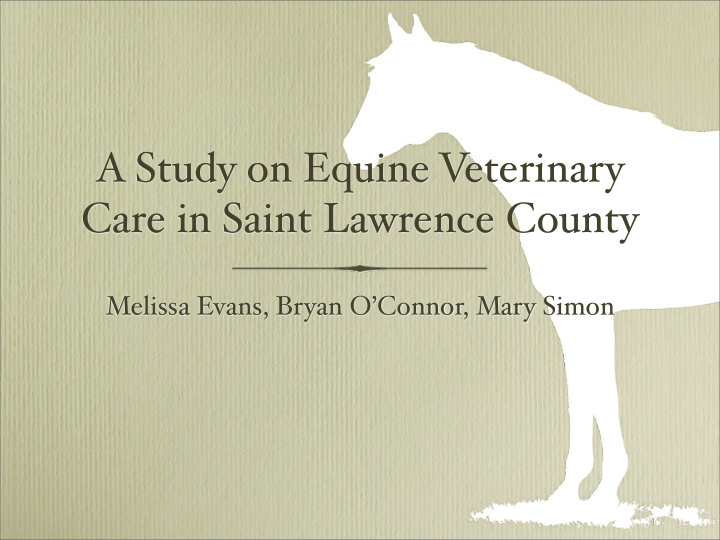



A Study on Equine V eterinary Care in Saint Lawrence County Melissa Evans, Bryan O’Connor, Mary Simon
Presentation Overview • Population and Research Sample • Research Questions • Procedure • Significant Data that Answers Research Questions • Conclusion and Questions
Population • Amateur, professional, and Amish horse & stable owners • St. Lawrence County • Sample Group Owned an Average of 5 Horses • Over 18 • Recreation/T rail Riding, Lessons, Competition, ransportation...etc. T
Research Questions • Is there a shortage of equine veterinarians? • Are horse owners satisfied with quality of care? • How do economics a ff ect veterinary care?
Methods Interview Pretest Revise Distribute Analyze
Shortage of Equine V eterinarians “With only one large 11% animal vet serving our area, I feel helpless when emergencies come up and have to wait. W e need more equine 89% medical tech.... Begging for it!” Shortage No Shortage - Horse Owner
Horse Owners Who Have Had Horses: Die Su ff er Further Damage 21% 18% “I tried to reach a vet to treat/put down an older horse for a leg injury - she su ff ered because I could not reach a vet. Mine was out of town - after hours of searching I finally reached one.” - Horse Owner
Response Time “My experience as a 30 new horse owner Number of Horse/Stable Owners with a lack of area vets was a complete 20 shock. I wait weeks for returned calls and keep my fingers crossed the vet will 10 come. I have waited 6 - 8 hours + for a vet to arrive.” 0 Very Dissatisfied Dissatisfied Satisfied Very Satisfied - Horse Owner Horse Owners
Horse Owners’ Satisfaction with Current Care 30 “While I have Number of Horse/Stable Owners not found fault with the quality 20 of care, our veterinarian is very hard to 10 reach.” - Horse Owner 0 Very Dissatisfied Dissatisfied Satisfied Very Satisfied Horse Owners
Where Horse Owners Receive V eterinary Care 30 “Not having good equine vet care is a huge problem! W e host an out of town vet regularly to help us with Number of Horse/Stable Owners lameness, metabolic issues, 20 x - rays, ultrasounds - the list goes on. Part of the problem is the reluctance of local vets to get the 10 equipment and specialized trainings to adequately care for horses.” 0 - Horse Owner Recieve All in SLC All Outside SLC Spec. Outside SLC Other Horse Owners
Hindering Business Growth “I have future business 25% plans that would benefit from availability of local equine veterinarians.” 75% - Horse Owner No Yes
Large Barns How Care is Satisfaction Level Number of Horses Further Damage? Death? Shortage? Received on Spec. Services Receives Care for Routine and Spec. 17 Y es Y es Y es Lameness, Dental, Eye Outside SLC Outside SLC All Care Received 14 Dissatisfied with No No Y es Lameness Care in SLC in SLC Dissatisfied with Routine in SLC/ 32 Y es Y es Y es Lameness/Dental/Eye Spec. Outside SLC Care in SLC Routine in SLC/ 23 Y es Y es Y es Satisfied with Lameness Care in SLC Spec. Outside SLC Dissatisfied with Routine in SLC/ 37 No No Y es Lameness/Eye Care in Spec. Outside SLC SLC
Specialty Care Lameness Dental Eye Injuries Recieve Outside SLC 0 7 14 21 “Not having good equine veterinary care is a huge problem! W e host an out of town vet regularly to help us with lameness, metabolic issues, x - rays, ultrasounds - the list goes on. Part of the problem is the reluctance of local vets to get the equipment and specialized trainings to adequately care for horses.” - Horse Owner
Questions Answered • Is there a shortage of equine veterinarians? • Are horse owners satisfied with quality of care? • How do economics a ff ect veterinary care?
Next Steps • Results Housed at CCE • Town Hall Meeting • Presenting in Albany • Developing W ebsite • Further Study • - Geography, Cost Benefit Analysis
End
What Horse Owners are Willing to Spend on Care 3000 Horse Owners Amount of Money Willing to Spend 2250 1500 750 0 Vaccinations Sutures Colic Rep. Care Life. Threat. Illness Dystocia Lameness Dental Eye D/I Handling “Whatever it takes.” - Multiple Horse Owners
Call Charges E ff ecting T reatment Plan Average Calls Per Year Non-Emergency: 4 30% Emergency: 1 Average Driving Distance 70% Veterinarian to Farm: 152 Miles Owners Willing to Travel to Non-Emergency Care: 64 Miles Owners Willing to Travel to Emergency Care: No Yes 145 Miles
Recommend
More recommend